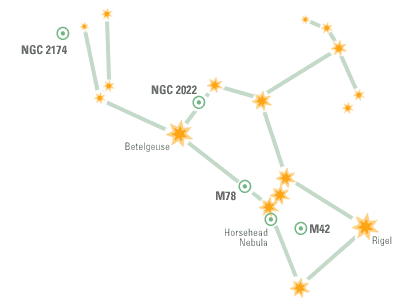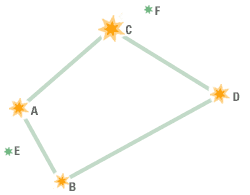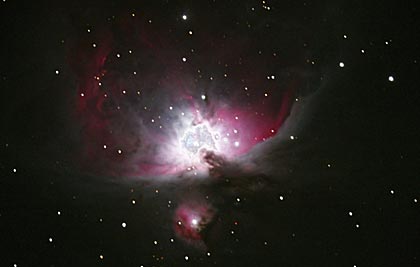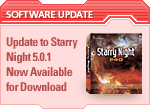 |
||||||||||||||||||||||||||||||||||||||||||||||||||||||||
|
If you have trouble viewing this newsletter, click here.
Orion (the Hunter) is one of the oldest and most recognized constellations in the sky. Orion is a very user-friendly constellation: its bold 3-star belt is often the first asterism people learn and it contains an inordinate number of hidden gems. So I felt that it was particularly appropriate to feature the constellation Orion this month as a way to highlight Imaginova’s acquisition of Orion Telescope & Binoculars. (Imaginova is the parent company of Starry Night.) The fit extends beyond the name: Orion is the most user-friendly telescope company out there. They are known for innovative, high quality products at great prices. They have truly first class customer service. Their catalog and website, www.telescope.com, are great educational resources for the new astronomer. See our press release for more information about the acquisition. See Orion up in the sky, or at www.telescope.com. Either way you’ll get spectacular observational “bang-for-your-buck”. Of course Starry Night is a great way to prepare yourself to observe the Great Orion Nebula, the red super-giant star Betelgeuse and blue-white giant Rigel and Orion’s other riches. Here’s how:
Don’t forget to explore the additional hidden gems in Orion and the other nearby constellations. Browsing the sky with Starry Night allows you to experience the thrill of discovery every time. Seth Meyers
The constellation of Orion is a great place to start your winter stargazing Visible towards the southern horizon from winter through spring in the northern hemisphere, Orion is one of the most easily recognizable and beloved constellations. By far, the most popular celestial gem in the constellation of Orion is M42, The Great Orion Nebula. Although it is 1500 light-years away, M42 is a great target to view in small telescopes. This is due not only to its brightness, but also to its wonderful cloud structure, which in telescopes takes on a clearly three-dimensional shape. Observers new and old come back to M42 time and time again because of the wealth of detail visible: pinpoint stars hang among uncanny, ghostly tendrils of glowing hydrogen that stream across space for trillions of miles. Astronomers call M42 a stellar nursery; when you look at this giant gas cloud you are seeing what our own solar system might have looked like billions of years ago. The nebula's reddish coloration (visible only in photographs) betrays the ionized hydrogen that predominates the composition of the cloud, but carbon monoxide and other complex molecules have also been detected. When viewed through a large telescope, the cloud takes on a wonderful greenish hue. T A fun challenge for amateur astronomers is to "bag" the two 11th magnitude E and F stars, shown here in green. Their proximity to far brighter stars makes them difficult to separate on nights of so-so seeing. On great nights, discerning the E and F stars is a good test of your telescope's optics. More Targets: The Horsehead Nebula was made famous from its beautiful photographs – it really does resemble what its name implies! The Horsehead can be found just below Alnitak (the leftmost/easternmost star in Orion's belt). The Horsehead is an extremely difficult target for medium aperture telescopes, and requires steady and dark skies to be seen even in a larger telescope. A far easier nebular target in the same area can be found above Alnitak: Located above Orion's belt, M78 belongs to the same large cloud of gas and dust as the main Orion nebula (M42). It has 2 companion nebulae (NGC 2067 & 2071). All 3 are reflection nebulae, and M78 is in fact the brightest reflection nebula. It is visible in binoculars but best seen through a telescope. NGC 2022 is a bright planetary nebula: a dying sun peeling off its outer shell. Because planetary nebulae are best viewed at high magnification, you should start out low (40x) to find the object, and then try 100x and 200x. The name "planetary" is misleading, as these objects are not planets at all but stars at the end of their life cycle. However, they do look something like cloudy planets, and this fact confused earlier observers whose incorrect naming convention has stayed with us to this day. NCG 2174 is a bright but diffuse emission nebula, a cloud of hydrogen gas very close to a young hot star (or multiple stars). In such clouds, energy from the stars heats up the hydrogen to 10,000°K until it glows with the distinctive red color one can see in long-exposure photographs. Betelgeuse is the only red star in Orion. Not only does this make it easy to identify, it also tells us we are looking at a giant star. Betelgeuse (pronounced beetle juice by most astronomers) derives its name from an Arabic phrase meaning "the armpit of the central one." The star marks the eastern shoulder of mighty Orion, the Hunter. Another name for Betelgeuse is Alpha Orionis, indicating it is the brightest star in the winter constellation of Orion. However, Rigel (Beta Orionis) is actually brighter. The misclassification happened because Betelgeuse is a variable star (a star that changes brightness over time) and it might have been brighter than Rigel when Johannes Bayer originally categorized it. Betelgeuse is an M1 red supergiant, 650 times the diameter and about 15 times the mass of the Sun. If Betelgeuse were to replace the Sun, planets out to the orbit of Mars would be engulfed! Betelgeuse is an ancient star approaching the end of its life cycle. Because of its mass it might fuse elements all the way to iron and blow up as a supernova that would be as bright as the crescent Moon, as seen from Earth. A dense neutron star would be left behind. The other alternative is that it might evolve into a rare neon-oxygen dwarf. Betelgeuse was the first star to have its surface directly imaged, a feat accomplished in 1996 with the Hubble Space Telescope. On the western heel of Orion, the Hunter, rests brilliant Rigel. In classical mythology, Rigel marks the spot where Scorpio, the Scorpion stung Orion after a brief and fierce battle. Its Arabic name means the Foot. Rigel is a multiple star system. The brighter component, Rigel A, is a blue super giant that shines a remarkable 40,000 times stronger than the Sun! Although 775 light-years distant, its light shines bright in our evening skies, at magnitude 0.12. Telescope observers should be able to resolve Rigel’s companion, a fairly bright 7th magnitude star. A heavy star of 17 solar masses, Rigel is likely to go out with a bang some day, or it might become a rare oxygen-neon white dwarf. Don’t forget to compare the colors of Betelgeuse and Rigel on your next outing under the stars! Sean O'Dwyer, Starry Night Times Editor
In January, the ringed planet is at its closest to Earth in 2005, making it an ideal time to observe. The exact date of closest approach is January 13th, but Saturn will be nearly as bright for a few weeks prior and after this date. The best time to look for Saturn is after 9 p.m. At this time Saturn will be high enough above the eastern horizon that it won’t be completely distorted by the atmosphere. To see the rings, use a magnification of at least 30x.
The Great Orion Nebula This month's winning photo submission is from Steve Norris. A Starry Night user, Steve does his imaging from a rooftop observatory in Wentworth Falls, Blue Mountains in Australia – at an elevation of 3000 ft above sea level. The Great Orion Nebula (M42) is easily visible to the naked eye as a fuzzy patch in the middle of Orion’s sword. What we call the Orion Nebula is just the central part of a larger cloud that stretches across several hundred light years. Four bright stars in a parallelogram near the nebula’s centre form the Trapezium. These hot young stars heat up the surrounding gas clouds, causing the nebula to emit light. The Orion Nebula is full of hot, bright blue stars and is an area of active star formation.
Photo Notes: M42-Orion Nebula, taken December 18th 2004 at 11:30 p.m. from Wentworth Falls, Blue Mountains approximately 80 km outside of Sydney, NSW Australia at 3000 ft above sea level. Celestron 9.25” SCT telescope. Canon 20D 8mp SLR camera set at ISO 1600 – three 30-second exposures stacked and enhanced in Photoshop and then filtered with Neat Image. PHOTO OF THE MONTH COMPETITION: We would like to invite all Starry Night users to send their quality astronomy photographs to be considered for use in our monthly newsletter. Featured submissions (best of month) will receive a prize of $25 USD. Please read the following guidelines and see the submission e-mail address below.
|
Jan. 2005
|
|||||||||||||||||||||||||||||||||||||||||||||||||||||||
 |
||||||||||||||||||||||||||||||||||||||||||||||||||||||||
|
|
||||||||||||||||||||||||||||||||||||||||||||||||||||||||

 he energy that keeps the nebula glowing so bright comes from the very hot, young stars in the brightest part of the cloud. Known as the Trapezium, this formation of four stars (from west to east: A, B, C, and D) is visible in most backyard telescopes.
he energy that keeps the nebula glowing so bright comes from the very hot, young stars in the brightest part of the cloud. Known as the Trapezium, this formation of four stars (from west to east: A, B, C, and D) is visible in most backyard telescopes.
